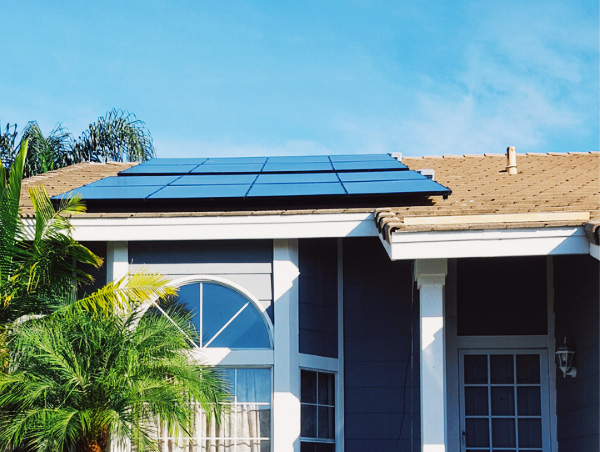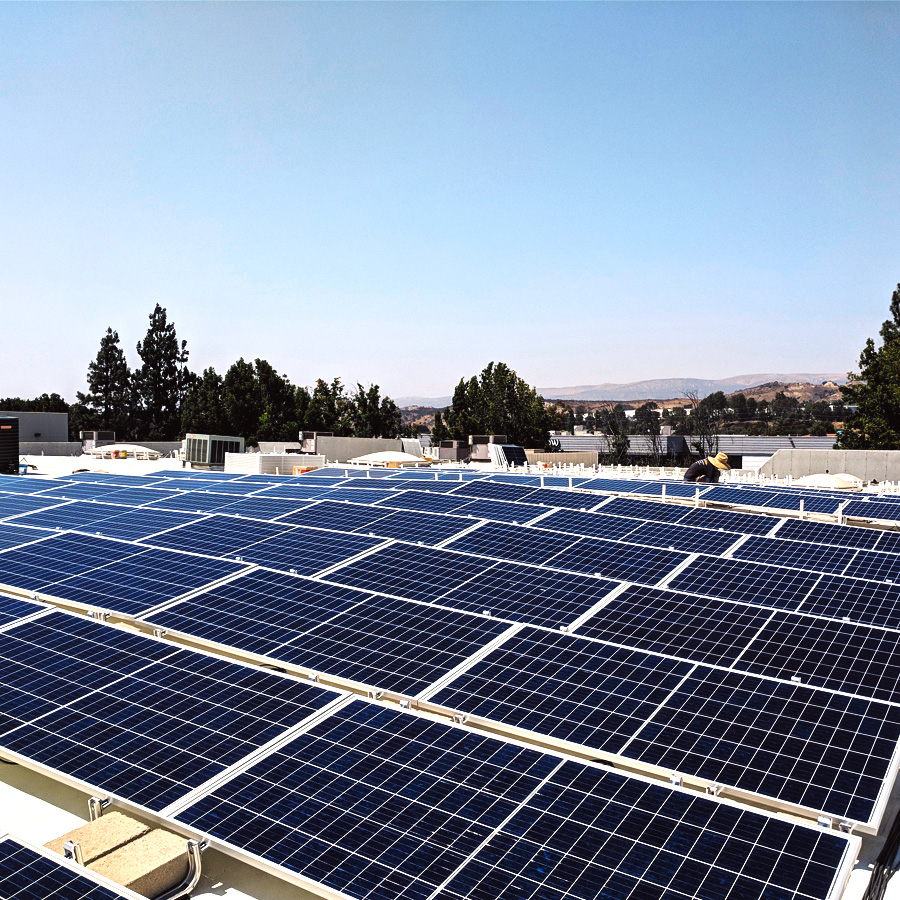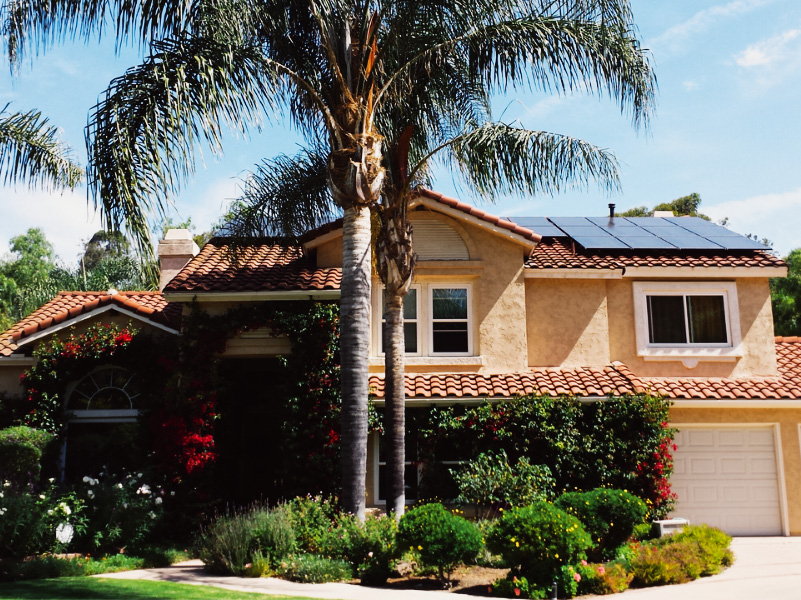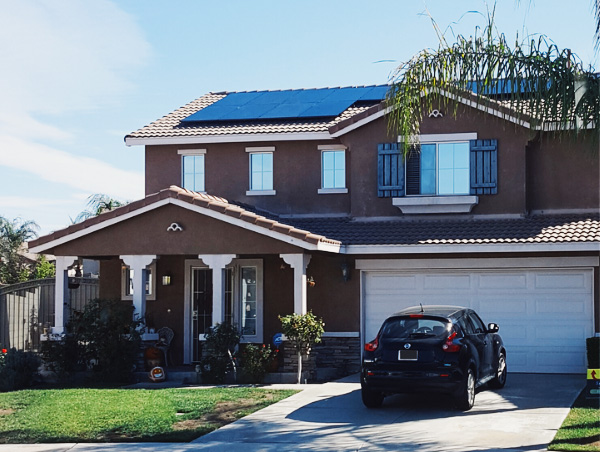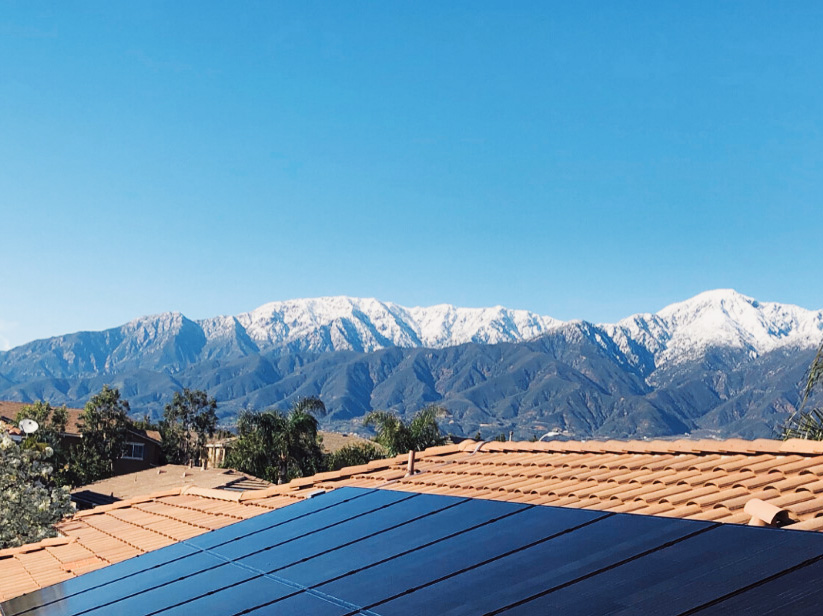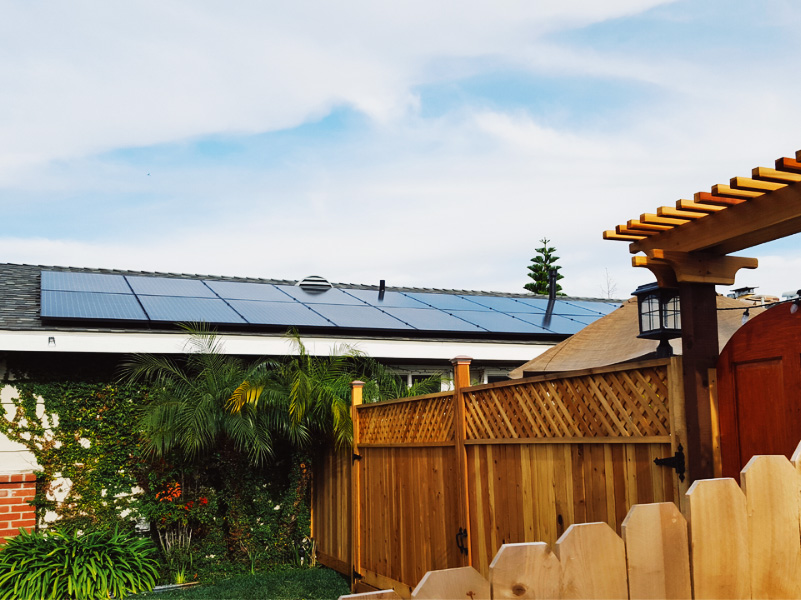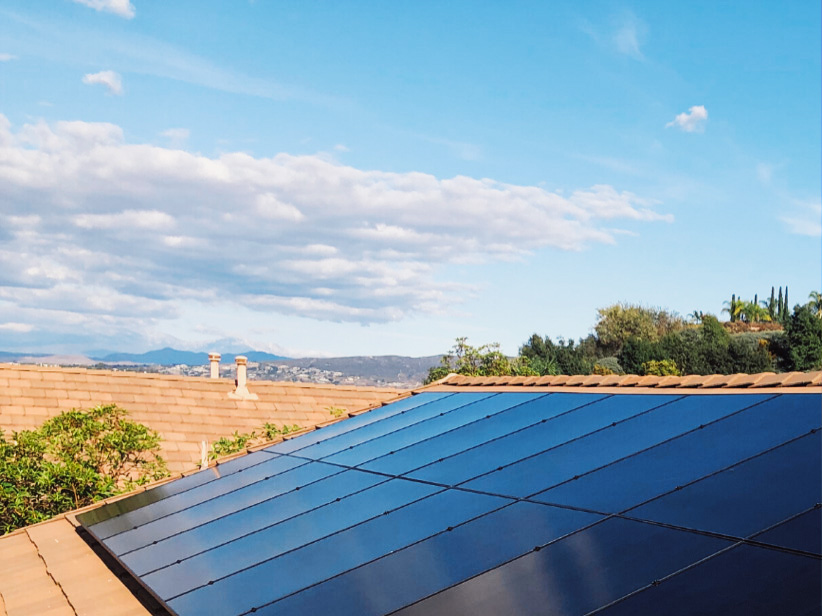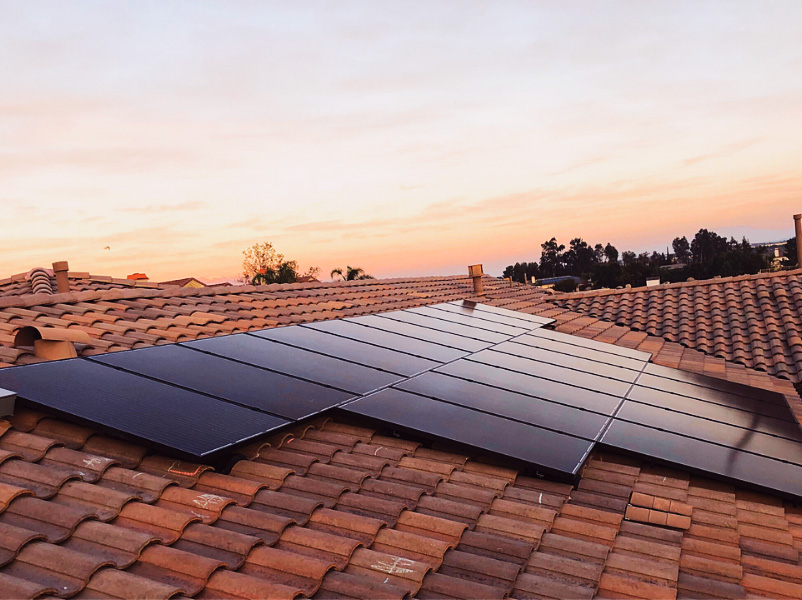Solar Incentives, Tax Credits and Rebates in California
California residents have access to a variety of solar rebates, tax credits, and incentives. These include federal tax credits as well as rebates offered by local utility companies. Keep in mind that eligibility for these incentives may depend on factors such as your location, utility provider, income, and interest in battery storage. Note – this is not tax advice and you should always consult a tax pro to see how this applies to you.
Federal tax credits
The Federal Solar Tax Credit, also referred to as the Residential Clean Energy Credit, is available to most California residents. It allows for a deduction of up to 30% of the cost of installing a solar panel system from your federal taxes. This means that if your solar installation costs $20,000, you could potentially receive a tax credit of $6,000 to be used to reduce your federal income tax for the tax year in which the system was installed. Essentially, it acts as a 30% discount on the cost of your home solar installation provided by the federal government.
Low income support
The Disadvantaged Communities Single-Family Affordable Solar Homes (DAC-SASH) Program was established by California to promote the use of renewable energy in disadvantaged communities. The program provides qualified homeowners with fixed, upfront, capacity-based incentives that can help reduce the cost of a solar energy system. Eligible homeowners can receive up to $3 per watt through the program, as per the California Public Utilities Commission. To qualify for the program, homeowners must meet the following criteria:
- Live in and own the home
- Receive electrical service from Pacific Gas & Electric (PG&E), Southern California Edison (SCE), or San Diego Gas & Electric (SDG&E)
- Enroll or be eligible for CARE or FERA income-qualified utility bill programs
- Live in a disadvantaged community (DAC) qualified area
If you believe you meet the eligibility requirements, visit the GRID Alternatives website for more information.
Property tax exclusion
In California, individuals who install a solar or wind-powered system to generate energy for their home or business are eligible for an exemption on property taxes for the added value the system brings to the property. This means that until 2025, property owners who install solar panels or other solar-powered devices on their property will not have to pay property taxes on the increased value of the property resulting from the installation of the system. This is a great benefit, particularly for those who require a larger system to offset their electricity consumption. It is a double benefit where not only you save on electricity bills but also on property taxes.
Net metering program
Homeowners who install solar panels on their property can participate in California’s net metering program. Net energy metering (NEM) is a system where utility companies offer credits to homeowners for the extra electricity generated by their solar panels and added to the electricity grid. Under net metering, homeowners are only billed for their net usage, which is the difference between the total energy produced by their solar system and the total energy consumed by their home. The program is offered by the three major investor-owned utility companies in California: Pacific Gas & Electric (PG&E), Southern California Edison (SCE), and San Diego Gas & Electric (SDG&E), and is regulated by the California Public Utility Commission.
To participate in the program, there are a few requirements to be aware of:
- A one-time interconnection fee between $75-$145 depending on the utility company
- Payment of non-bypassable charges that fund low-income, energy efficiency, and other similar programs
- Switching to time-of-use (TOU) energy rates At the end of a 12-month billing period, customers may receive compensation for any surplus credits on their account at the “fair market value” through net surplus compensation (NSC) which changes based on the 12-month rolling average of the market rate for electricity and can be found on your utility company’s website.
Similarly, municipalities and other electric cooperatives such as Los Angeles Department of Water and Power (LADWP) also provide net metering credits to residential solar owners in their territories, but the value of the credit is determined by the policies set by the municipal utility company or electric cooperative’s governing board.
In summary, California residents have access to a variety of solar incentives, including federal tax credits, local utility rebates, and programs to offset the cost of solar energy systems for qualified homeowners. Want to learn more? Call 1-844-SUN-EASY to learn what installing solar could do for you!
The 5 Key Advantages of Solar Energy for Businesses
As more and more businesses look for ways to reduce costs and become more sustainable, solar energy is becoming an increasingly popular option. Solar energy offers a wide range of advantages for businesses, including cost savings, environmental benefits, and increased energy independence. Here are five key advantages of solar energy for businesses:
Cost savings
One of the biggest advantages of solar energy for businesses is the cost savings. Solar energy can help businesses save money on their energy bills by reducing or even eliminating their reliance on traditional energy sources. According to the National Renewable Energy Laboratory (NREL), a typical commercial solar panel system can offset between 50-70% of a business’s electricity consumption. This can lead to significant cost savings over time.
Increased energy independence
Solar energy also provides businesses with increased energy independence. By generating their own power, businesses can reduce their dependence on the traditional energy grid and be less affected by power outages and fluctuations in energy prices.
Environmental benefits
Another advantage of solar energy for businesses is the environmental benefits. Solar energy is a clean and renewable energy source, which means it does not produce any emissions or pollutants. By installing solar panels on their properties, businesses can decrease their carbon footprint and contribute to a more sustainable future.
Increase in property value
Installing solar panels on your property can increase the property value, according to a study by the Lawrence Berkeley National Laboratory, solar systems can increase the value of a property by about 4.1% on average. This is because buyers are willing to pay more for a property that generates its own power.
Tax Incentives and subsidies
Many governments offer tax incentives and subsidies to businesses that install solar panels on their properties. This can help to offset the initial cost of installation and make solar energy a more affordable option for businesses.
In summary, solar energy offers a wide range of advantages for businesses, including cost savings, increased energy independence, environmental benefits, increase in property value, and tax incentives and subsidies. As the cost of solar technology continues to decline and more businesses adopt solar energy, it’s becoming a more viable option for businesses of all sizes. Want to learn more? Call 1-844-SUN-EASY to learn what installing solar could do for you!
The Impact of Residential Solar Energy on the Environment
The use of solar energy is on the rise as more and more homeowners are turning to this renewable energy source to power their homes. The installation of solar panels on your home not only reduces your energy costs but also has a significant impact on the environment.
Reducing greenhouse gas emissions
One of the most significant impacts of solar energy on the environment is the reduction of greenhouse gas emissions. Fossil fuels, such as coal and natural gas, are the main sources of energy for electricity generation. However, burning these fuels releases carbon dioxide and other harmful pollutants into the atmosphere, contributing to climate change. By installing solar panels on your home, you are directly reducing your reliance on fossil fuels, which in turn reduces the amount of greenhouse gas emissions. This, in turn, helps slow down the effects of climate change and preserve our planet for future generations.
Decreasing demand for fossil fuels
A typical residential solar panel system can offset the equivalent of three to four tons of carbon dioxide emissions per year, decreasing the demand for fossil fuels, which are the main sources of energy for electricity generation. According to the National Renewable Energy Laboratory (NREL), a typical residential solar panel system can offset the equivalent of three to four tons of carbon dioxide emissions per year. That’s the same as planting over 100 trees annually or taking one car off the road.
Preserving natural resources
Another benefit of solar energy is that it helps to preserve natural resources. Solar energy is generated through the use of photovoltaic cells, which convert sunlight into electricity. Unlike fossil fuels, which are finite resources, the sun’s energy is abundant and will be available for generations to come. By harnessing this renewable energy source, we can reduce our dependence on finite resources, such as coal and natural gas, and preserve them for future generations.
In summary, the installation of solar panels on your home not only reduces your energy costs but also has a significant impact on the environment. By reducing greenhouse gas emissions and preserving natural resources, solar energy helps to preserve our planet for future generations. Want to learn more? Call 1-844-SUN-EASY to learn what installing solar could do for you!
Going Solar: A Step-by-Step Guide for Homeowners
Going solar is a great way for homeowners to save money on their energy bills and reduce their carbon footprint. By installing solar panels on your property, you can generate your own electricity and potentially even sell excess power back to the grid. The process of going solar may seem daunting, but it’s actually quite simple and straightforward. Here is a step-by-step guide for homeowners looking to go solar:
Conduct a site assessment
The first step in going solar is to have a professional conduct a site assessment. This assessment will determine the size and type of solar system that is best for your home and energy needs. It will also take into consideration factors such as the direction and angle of your roof, shading, and local weather patterns.
Research and Compare solar providers
After getting your site assessment done, research and compare different solar providers and their pricing, warranties and services.
Get quotes and choose a provider
Get quotes from multiple providers, compare them and choose the one that best suits your needs. Make sure to check the company’s reputation, customer reviews and certifications.
Sign a contract and secure financing
Once you have chosen a provider, sign a contract and secure financing if needed. Some providers offer financing options, while others may require you to pay upfront.
Design and Installation
The design and installation phase is where the actual solar panels are installed on your property. This process typically takes a few days and is typically handled by a team of trained professionals.
Connect to the grid
Once the installation is complete, your solar energy system will be connected to the grid and you can start generating your own electricity.
Monitoring and maintenance
After the installation, monitor your system regularly and schedule regular maintenance check-ups to ensure optimal performance and longevity of the system.
Going solar is a great way to reduce your energy costs and your carbon footprint. With a little research and planning, the process of going solar can be easy and straightforward. By following these simple steps, you can be on your way to generating your own clean energy in no time. Want to learn more? Call 1-844-SUN-EASY to learn what installing solar could do for you!
California Leads the Way in Solar Panel Installations
California is known for its sunny weather and progressive environmental policies, and it’s no surprise that the state is leading the way in solar panel installations. The Golden State has been at the forefront of the solar energy movement for decades, and it continues to set the standard for other states to follow. Here’s a closer look at how California is leading the way in solar panel installations and what other states can learn from its example.
Renewable energy goals
One of the key reasons why California is leading the way in solar panel installations is its aggressive renewable energy goals. The state has set a target of generating 100% of its electricity from renewable sources by 2045, and solar energy is a big part of that equation. To meet this goal, the state has implemented policies and incentives to encourage the installation of solar panels on homes and businesses. This has helped to increase the amount of solar energy generated in the state and make it more accessible to residents and businesses.
Plenty of sunshine
Another reason why California is leading the way in solar panel installations is its abundance of sunshine. The state receives more sunlight than most other states in the country, which means that solar panels can generate more energy. This, in combination with the state’s policies and incentives, has made it easier and more cost-effective for residents and businesses to install solar panels and generate their own power.
Largest solar industry
California’s solar industry is also well-established and growing rapidly. According to the Solar Energy Industries Association (SEIA), California is home to more solar jobs than any other state in the country. The state’s solar industry currently employs over 100,000 people and is projected to continue growing in the coming years.
Environmental impact
Finally, California’s solar panel installations have a huge impact on the environment. According to the California Energy Commission, the state’s solar installations have avoided the emission of over 13 million metric tons of greenhouse gases since 2006, which is equivalent to taking 2.8 million cars off the road for a year.
In conclusion, California is leading the way in solar panel installations because of its aggressive renewable energy goals, abundance of sunshine, well-established solar industry and positive environmental impact. Other states can learn from California’s example by implementing policies and incentives to encourage the installation of solar panels, as well as supporting the growth of the solar industry. Want to learn more? Call 1-844-SUN-EASY to learn what installing solar could do for you!
The Truth why all Solar Panel Warranties are Not the Same
Simply Solar LLC has an industry-leading warranty on their solar power systems. It covers you for 25 years. Of course, if you look around, almost everyone else has a 25-year warranty too, so how can we call ours “industry-leading”? The answer is in the details.
Warranties on solar panels come from the panel manufacturer, not the solar installation company. This means that if a manufacturer makes a good quality panel, and has confidence in their product, they will have a really good warranty. When trying to compare two 25-year warranties, the first thing we need to focus on is not the time, but rather the degradation of the panel. Yes, in 20 years those cheaply made panels may still be producing electricity, but at what rate? Maybe 50%? But since they are technically still working, the warranty doesn’t kick in. What a good solar panel company guarantees is that your panels will not just be performing in 20 years, but that they will be performing very well, or they’ll be replaced.
This is why Simply Solar LLC chooses to use high-quality Solaria panels. Solaria panels come out the gate leagues above their competitors by producing 400 watts per panel, as opposed to their competitors’ mid to lower 350-watt range. They also have 20% greater efficiency than their competitors’ panels. This means you need fewer panels to produce even more electricity. The warranty for these panels is 25 years, but the breakdown of this warranty is where you see the confidence in their product.
In the first year of owning your panels, each panel must be performing at 98% or better (usually 99-100%), or they will be replaced at no cost to the owner. At ten years of owning the panels, there would be expected wear and tear from the weather, but each panel must be performing at 95%, or they get replaced at no cost to the owner. That means that at a decade of use, those panels can only have a 3% loss or they are replaced. At 25 years of ownership, each panel must be performing at 86% or above, or they are replaced at no cost to the owner. This is a first-class warranty, and on top of that, when you work with Simply Solar LLC we handle all of it. We deal with the manufacturer and warranty information. Solar companies that hire subcontractors can encounter issues of dispute between the company and the subcontractor as to who is responsible to fulfill the labor part of the warranty, leading to delays in service. Since Simply Solar LLC does everything in-house and does not hire subcontractors, there are no complications; we take care of everything.
Solar systems require more than just panels to operate, and one of the key parts is the inverter. There are two types of inverters, centralized and micro. Both of these types carry warranties, but again, the truth is in the details.
Centralized inverters usually have a 10-15 year manufacturer’s warranty, and will often give you the option to purchase an extended warranty but with that, you would essentially just be purchasing the second inverter to replace the first. Most likely your centralized inverter will go out before your panels do, which means you will have added complications with replacement. Since centralized inverters cannot track individual panels for efficiency, if you suspect that your system is not performing well, the solar company would need to come out and disconnect your panels one at a time to try and find the bad panel. That process is going to take them a lot of time and money so they aren’t going to want to do that unless your whole system goes out. This entire situation opens up a loophole for them to say that there isn’t anything wrong with your panels, but rather that you increased your usage, leaving you with a faulty panel and an unused warranty.
The microinverters (the other type of inverter) on our Solaria panels, come with a 25-year warranty. The microinverters allow for the data collection on every individual panel, and they can collect those data points every 15 minutes so you can actually see if it is performing optimally. You have access to all of this data, as does Simply Solar LLC. We actively watch and monitor this data to make sure that your system is working correctly for the 25 years of the warranty. With our product’s warranties, absolutely everything is covered for 25 years, the panels, the inverters, and the labor. 25 years is a long time, and you may not stay in your home for that entire time, so rest assured that the manufacturer’s warranty will go to the next owner of the home.
On top of the manufacturer’s warranty, Simply Solar LLC also has a 10-year roofing warranty. This means that if work is needed where we attached the panels to your roof within 10 years, we will fix it. In addition, during those 25 years that your system is warrantied, we will remove and reinstall your system one time for re-roofing, at no cost to you! Be wary of companies that offer a longer roofing warranty because they are most often empty promises. Roofs don’t last forever, so if you’re seeing problems with your roof 10 years after your solar was installed, you need a roofing company because it’s time to replace your roof whether or not you had solar installed. This is why we offer one free solar system removal and reinstall, because sometimes you just need a new roof! If a solar company is telling you that they can warranty your roof for 25 years, just be cautious, because they may not plan on being around to fulfill that warranty. It is a sad and disappointing reality, but some companies are created to make a quick buck and then dissolve so they don’t have to worry about anything they promised because they won’t exist when it comes time to make good on those promises. We want to combat those companies by being an honest company that gives you a quality solar system, with no surprises. Simply Solar LLC wants to be around for a long time because we believe in what we do. But this information may have got you wondering “Okay, but what if Simply Solar LLC goes out of business?” Well, we’ve got you covered then too. We’ve chosen a manufacturer that’s been in the business for over 20 years and is in California. If one of your panels stops working properly, their 25 year warranty still applies. They will pay fair market value to get the panel replaced. So they send you a free panel, you hire a company that will install it and send the manufacturer the invoice and they will reimburse you for labor costs.
Now that you know the details of different warranties, you can see why Simply Solar LLC chooses to use the best products with the best warranties. If you decide to go solar, we want you to do so with the confidence to know that you are guaranteed an efficient and properly operating system that will save you money.
5 Things You Can Do To Lower Your Electric Bill in California
We see it all the time, electric bills that are just way too high even though you think you’re doing everything right. We get it, and we want to help. Here are some helpful tips for lowering your energy usage.
Seal all possible air leaks and insulate your home
Air can find its way through the smallest of gaps, so if you want to keep your heated or cooled air inside your home, then you need to make sure you seal everything. Common culprits are windows and doors without weather stripping or proper caulking, but you don’t want to forget about checking your attic, basement, or crawlspace for leaks. Homeowners typically save up to $200 a year in heating and cooling costs by air-sealing their homes and adding insulation. While you’re looking at sealing your windows, you may want to consider eventually replacing them with Energy Star-certified windows that can reduce your energy bill by an average of 12%!
Use energy-efficient lighting
Lighting has come a long way in energy conservation, but it only works if you update those old fixtures and bulbs! Energy Star certified fixtures use 75% less energy and Energy Star certified light bulbs use 70-90% less energy. On top of that, Energy Star certified bulbs last 10-25 times longer than incandescent bulbs. And above all, turn off lights when you don’t need them; it costs almost $20 a year to leave one light on for 8 hours a day.
Use Energy Star-certified appliances and fixtures
There are Energy Star certified versions of almost every appliance in your home. If you are in the market for a new large appliance such as a dishwasher, washer/dryer, or even a pool pump, choosing a certified one will save you energy and money. A dishwasher that has been certified can cost less than $35 a year to run, not to mention they typically use less water too. Dishwashers aren’t the only ones saving water; certified washing machines use 35% less energy and water. If you want to save even more, 90% of the energy that goes into operating a washing machine is for heating the water. There are formulated detergents available for cold water washing. The second step in doing laundry, drying, can also be a big energy drainer without the right equipment. Replacing your old clothes dryer with an Energy Star certified model can save you $245 a year. If you think that’s a big savings, a certified pool pump is about 70% more efficient than conventional models and can save you up to $340 a year! But don’t think it’s only large appliances that can save you money; there are Energy Star certified computers, monitors, printers, network equipment, DVD players, sound systems and the list goes on and on! All of these small appliances run anywhere between 20-65% more efficiently. They may seem small, but it all can add up to a big utility bill! It’s also a good idea to plug these small items into a power strip that you can switch off when not in use, this will stop the electricity trickle that appliances pull when they are off but still plugged in.
Heating and cooling
The first step to saving on heating and cooling is getting a programmable thermostat. When properly used, these can save you about $180 a year. Making sure that you take care of your HVAC equipment is critical. Make sure your filters are clean, there’s good airflow around the outdoor components, and a professional gives it a good tune up annually to keep it at peak performance. An HVAC system that has to work harder uses more energy. If you are in the market for a new HVAC system, look for one that is Energy Star certified. And when possible, use a certified ceiling fan so you can turn down your air conditioner.
Install solar
Installing solar is on this list because even if you do all the things listed above, eventually, the utility rates will increase and your energy bill will creep up again despite you doing everything right. Utilities go up an average of 4% every year. If you have solar, those rate increases don’t affect you because you are generating your own power.
We want everyone to be as energy efficient as possible so we hope that you’ll try some of the tips we shared! You can call 1-844-SUN-EASY to learn what installing solar could do for you!
What Happens to My Solar When the Sun Isn’t Shining?
The sun is your solar panel’s best friend, it’s what makes the entire system work. Obviously, the sun goes down at night, and sometimes gets blocked by clouds or trees, which brings up the question: what happens to my solar system when the sun isn’t around? It’s a valid question, after all, what’s the point of going solar if a cloudy day makes it so you can’t power your home right?
To answer these questions we’ve got to understand what your solar system design was based on. When you decide to go solar with Simply Solar we will ask to take a look at your electric bills from the past 12 months. Why 12 months? Most people’s electric bills fluctuate throughout the year because of seasonal changes or behavioral patterns. If we only look at a couple of bills it would give us an inaccurate depiction of how much energy you really use on a regular basis. We take the average amount of energy you use in the entire 12 month period and design a system to cover that usage. Once your panels are up and your system is in place, it will only take your panels about 5 hours to create enough energy to power your home for 24 hours. You may be wondering why we don’t just install a smaller system then, right? Well, here’s where it gets interesting.
Your utility company takes all that extra electricity that your panels are producing during the day, and sells it to other people. They don’t get to do this for free though. There’s a law, California Net Energy Metering (NEM), that requires the company to compensate the homeowner (and don’t worry, even if the law gets changed, if you purchase solar before the change you are grandfathered into the original law for 20 years). The utility company will credit your account in the form of kWh (kilowatt hours). Kilowatt hours are the amount of kilowatts you use over time. This means that at night, when the sun is down and your panels aren’t creating energy, you’re using electricity from the utility company, but you’re not paying for it because you have the credits on your account! Whatever you don’t use just rolls over to the next day. You can think of these kWh credits as the old way that rollover cell phone minutes used to work. These kWh credits continue to rollover day by day, month by month, until you hit 12 months. When you get solar for your home, you no longer have a monthly bill from your utility company for your energy use. Your only monthly bill is minimum taxes and fees that everyone has to pay that are not related to the amount of power you used. You are on a 12 month billing cycle, so you will still receive monthly statements so you can track your usage, but there is no bill for your energy use until the end of the 12 months. The benefit of this system is that if you use a lot of electricity in the summer months trying to mitigate the heat, you may be using more than your solar panels are producing and therefore you are using some of the utility company’s electricity, meaning you would be paying an electric bill if on a monthly billing cycle. However, when the winter comes you may use much less electricity than your solar panels are producing and therefore gaining a lot of kWh credits in your account. As your usage and your credits roll over to the next months, they end up cancelling each other out! So by the end of your 12 month cycle, any extra power that you needed to use from the utility company will have been paid for by the kWh credits you accrued during the year thanks to your solar panels!
At the end of the 12 month billing cycle, this is where you will see the difference between a well designed system, and a system that wasn’t really designed based on your needs. If your system was too small, you will end up having used more electricity than you created, resulting in you needing to pay the utility company. If your system was too big you will end up with a large amount of kWh credits. Now, you may have heard that your utility company will buy those credits from you, so why not aim for extra at the end of the year? It’s true that if you produce more electricity than you consume then you are classified as a generation facility (basically a little power plant), and the utility company has two options; they can either buy it from you, or roll it over to the next year. The problem with this system is that they buy it from you at the wholesale price, which is pennies to the dollar. For example, if in Southern California a kWh costs $.23 from the utility company, they will only pay you $.03 for that same kWh. If you choose the roll over choice, they still only value it at the $.03 a kWh rate, so either way it’s a net negative for the homeowner. This is why it’s so important to get a solar system that is the right size for your usage, to limit the under and over production of electricity.
Does that mean you can never change your energy usage? We know that things change from year-to-year, and you may not use the same amount of electricity you did 5 years ago. Maybe you’re planning on getting an electric car, or adding air conditioning, your electricity usage is surely going to go up. That’s why Simply Solar chooses to use products that allow for easy expansions and add ons. An important part of a solar system is the inverter. These are where the DC electricity that the panels create gets converted into AC electricity that we can use to power our homes. Inverters come in two options, a centralized inverter or a microinverter. A centralized inverter requires that each panel in the system connects back to the inverter in order for the system to work. This means that the centralized inverter must be sized for the exact number of panels it connects to, you cannot simply add another panel to the system later because it would overload the inverter. The other drawback of the centralized inverter is that it is much more difficult to diagnose panel malfunctions because if one panel goes out, they all go out. Do you remember the old style of string lights, where if one went out then they all went out, making it nearly impossible to figure which bulb was burnt out? It’s just like that. A centralized inverter can only convert as much electricity as it’s lowest performing panel, so if one panel isn’t working, then nothing is working. At that point, each panel may need to be removed one at a time to try and find the issue. There may not even be anything wrong with a panel but if a neighbor’s tree got a bit taller and is shading a panel so it can only produce at 10%, then that means everything else is only performing at 10%. You can see why this is a less than ideal situation to be in. That’s why Simply Solar chooses to use microinverters. Microinverters are built into each panel, so each panel converts DC to AC. This means that there is no size limitation, and you can add on another panel whenever you want because it has its own inverter! This also means that since these panels can work independently, if something goes wrong with one, it does not affect the others. If that neighbor’s tree just keeps getting taller and one of your panels gets shaded to the point that it’s only performing at 10%, then that means you have one panel performing at 10% and the rest of them performing at 100%. The system is also monitored by an app that identifies the panels independently so if one is malfunctioning, we can determine which one it is immediately and it can be repaired or replaced under our 25 year parts and labor warranty. All of this may sound complicated when it comes to wanting to add on to your solar system, but we’ve made it simple for you. All you have to do is call us. We will look at your bills and design an addition for you. We deal with everything: design, permitting, installation, and inspections.
Now you know what happens to your solar power when there’s no sun, what we base our solar power systems designs on, how important the right equipment is, and how it all ties together. Choosing a solar company that understands all of this is crucial to getting you all the benefits that come with going solar. Simply Solar is that company. We pride ourselves on our customer service, quality products, and great workmanship that is done entirely in house from start to finish. You can call us at 1-844-SUN-EASY to learn more about what solar can do for you!
